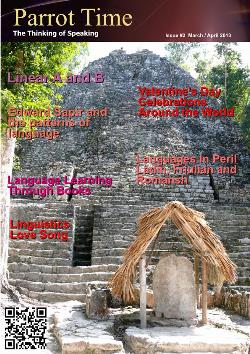The Rosetta Stone
Triple Cypher

|
The Rosetta Stone is an Ancient Egyptian artifact which provided the key to understanding hieroglyphic writing. It is a black basalt fragment of a stela (a free-standing stone inscribed with Egyptian governmental or religious records) discovered in Egypt in 1799. While rather large, being three-quarters of a ton in weight and approximately 120cm high, 75cm wide, and 30cm deep (47in x 30in x 12in), it is the writing on it that made it famous. It contains an ancient royal decree written in the three scripts of Egyptian hieroglyphics, Demotic, and Greek, and thus provided a connection between the three. Hieroglyphics 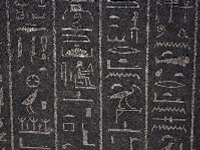 Sample of hieroglyphics One of the oldest writing systems of the word is Ancient Egyptian hieroglyphics, which were used for nearly 3500 years, from around 3100 BC until the end of the fourth century AD. The name "hieroglyphics" came from the Greeks who discovered the writings. They called it "ta hieroglyphica" or "sacred carved letters". Hieroglyphics were mainly reserved for religious or governmental mandates, and the the language was used to inscribe tombs, temples and other monuments. Hieroglyphics were not letters like we think of in our modern alphabets. They were simple drawings of common natural and man-made objects. They were not, however, like cave paintings to represent basic ideas. They were richer than our own alphabets, far more complex and more difficult to learn. The number of glyphs used varied over time, from under one-thousand to almost six-thousand. The name "hieroglyphics" came from the Greeks who discovered the writings. They called it "ta hieroglyphica" or "sacred carved letters". Part of the complexity was that glyphs were signs that indicated sounds (called phonograms) or represented complete words (called ideograms). Similar to modern Arabic and Hebrew, only the consonants were written, no vowels. For example, in English, the word "cloud" would be spelled "cld". However, this could also represent "cold" "could" "colada". To tell the difference between such words, signs were added called "determinatives", which gave specific meanings to certain words. In the case of "cloud" as "cld", the determinative for cloud would be placed at the end of the word. A determinative had no phonetic value. 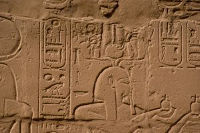 Hieroglyphics carved into a wall One might wonder why they would bother spelling out a word at all if they could just use a determinative instead. For example, instead of using three glyphs to spell out "cld", then adding a determinative, why not just use a single glyph to represent a cloud? While determinatives didn't represent sounds, they did represent ideas, and they interacted with words differently. Think of them as putting a word into context. If in English, someone uses the word "plant", ("plnt") you don't know if they are referring to the act of planting or a living plant. In that case, you could use a determinative that represents action to clarify the first, and another that means life to clarify the second. If you were using the word "plant" to talk about a factory, then a determinative for building could be added. Hieroglyphic inscriptions were normally written in rows from right to left or in columns top to bottom. However, they might also be written from left to right, similar to most modern alphabets. The way to tell which way to read an inscription was to look at the direction toward which animals and people faced or walked. They always faced toward the beginning of the line. To add to the complication of reading, hieroglyphics had no punctuation or spaces between words or sentences. Hieratic 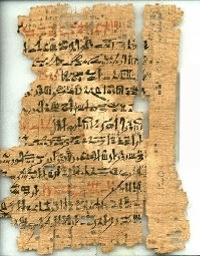 The beginning of the ancient Egyptian 'Loyalist teaching' originally inscribed in stone, but later copied in hieratic script onto papyrus Because of these complexities, as well as the sacred attachment of hieroglyphics, the Egyptians later developed hieratic, which was a sort of abbreviated version of hieroglyphics. Despite the name, hieratic was not a derivative of hieroglyphics. The name "hieratic" derives from the Greek phrase "γράμματα ἱερατικά" (grammata hieratika; literally "priestly writing"). This was first used by Saint Clement of Alexandria in the second century AD, and at time it was used only for religious texts. Later, it was used to record some government decrees and business transactions, but not for sacred purposes. It was more commonly written with ink and brush on papyrus, and shows no indication of being a descendant of hieroglyphs, which were normally carved in clay or stone. The two writing systems more likely evolved along the same timeline, rather than one after the other. Demotic Over time, a form of script evolved from northern hieratic that became very popular. It was called Demotic (from Greek: δημοτικός dēmotikós, "popular", not to be confused with demotic Greek). This became used for much of the government documents.  Small sample of Coptic script Around fourth century A.D., Christianity had become more widespread in Egypt, and hieroglyphics were abandoned because of their association with pagan gods. Demotic wasn't a taboo language like hieroglyphics, so remained in use, but eventually evolved into Coptic. Coptic was a mix of the Greek alphabet and some Demotic characters for Egyptian sounds that weren't denoted by the Greek language. It was the first alphabetic script used for the Egyptian language. Probably soon after that, the knowledge of how to read hieroglyphics and hieratic was lost. Ptolemic Dynasty In ancient times, Greece had originally been united by Philip of Macedon, then ruled by Alexander the Great. After defeating the Persian forces, Alexander then took his army to Egypt where he was welcomed as a conquering hero. The Egyptians made him a god and pharaoh, but he had other campaigns to wage, so he took his army to the Middle East and the Indus River Valley, leaving a regent in charge of Egypt. These decrees were set in stone for all to read... in hieroglyphics, Demotic, and Greek. When Alexander died in 323 BC, his empire was divided among his three most trusted generals, and the throne of Egypt came to Ptolemy I. The Egyptians welcomed him as part of Alexander's family, and he became a pharaoh, thus setting up the Ptolemic Dynasty, the 32nd and last of Egypt's great dynasties. By tradition, all his male successors were called Ptolemy and all female ones were named Cleopatra (Greek for "father's glory"). Ptolemy IV (Ptolemy Pilopator) was a weak king, and when he died at the age of 41, his son, Ptolemy Epiphanes, was only a small boy of five and too young to rule. Until he was old enough, the empire fell into turmoil as different regents fought for control. During this time, surrounding empires, including the Roman, were vying for control and attempted to take advantage of the internal conflict. The Ptolemic Dynasty lost land in several areas. 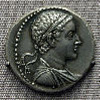 A tetradrachm (Ancient Greek silver coin) portraying Ptolemy V In an attempt to restore power and control, it was decided to coronate the then 13 year old Ptolemy V in the city of Memphis in 196 BC. To further solidify his royal credentials, a series of royal decrees were passed by a council of priests to affirm the dynasty of kings. The decrees praised Ptolemy, claiming him as the manifestation of divine grace, and portraying the young king as a great benefactor of Egypt who adorned the temples of Egypt's traditional gods, cancelled debts, reduced taxes, freed prisoners, and numerous other deeds. These decrees were set in stone for all to read. During the Ptolemic Dynasty, both Egyptian and Greek languages were used, so to make sure that as many people as possible could read these decrees, they were written in hieroglyphics, Demotic, and Greek. Napoleon and the Egypt Campaign 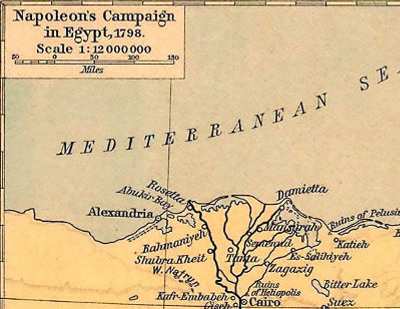 Around the turn of the 19th century, prominent French general Napoleon Bonaparte began a campaign of conquest over every major European power. In 1798, he turned his forces toward Egypt, hoping to take there control and thus undermine Britain's trade route to India. However, Napoleon didn't just plan a military attack. He wanted a complete infiltration of Egypt, gathering information about Egypt's past and present people, environment, culture and resources. Napoleon reasoned that to rule a country, one must know everything about it. To that end, he assembled a "think tank" of scientists, scholars, mathematicians, chemists, archaeologists and more. He called them the "Institute of Egypt", and they accompanied him on the invasion when his forces landed off the coast of Egypt at Aboukir Bay in August 1798. However, the British navy crushed most of the French fleet, leaving Napoleon and his army stranded. Finding the Rosetta Stone Napoleon was able to return to France and continue his war against the world, leaving some troops to maintain control as well as the scientists to do their work. They settled in around the Nile Delta, and while the military built forts, the Institute collected artifacts. 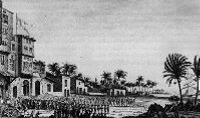 Napoleon's troops in Rosetta During the summer of 1799, Napoleon's soldiers tore down some ancient walls to expand Fort Julien in the town of Rosetta (modern day Rashid), near Alexandria. Captain Pierre-Francois Bouchard found a black stone when guiding the work, and noticing that it was covered in ancient writing, turned it over to the Institute. The Institute's scholars were able to determine that the stone was some kind of decree and immediately began attempts to translate it. They named the stone the "Rosetta Stone" in honor of the town in which it was discovered, and they made several copies of the writing on it, which was in three scripts. They had found a piece of one of the decrees about Ptolemy V, though they didn't know it at the time. British forces landed on Aboukir Bay and were finally able to overcome the French troops in 1801. A dispute then arose over the artifacts and findings of the Institute. The French wanted to keep them for their own, but the British considered them forfeit in the name of King George III and wanted to take them back to England. One of the scientists, Etienne Geoffroy Saint-Hilaire, wrote to the English diplomat William Richard Hamilton, threatening to burn all the discoveries, in reference to the burning of the Library of Alexandria (destroyed during a Muslim invasion in 642). The British gave in and insisted only on the delivery of the artifacts. The scientists attempted to hide the Rosetta Stone but failed, and they were only allowed to take the plaster casts and copies of the text they had made. The Stone was brought back to Britain and presented to the British Museum in 1802. |
| Triple Cypher - Rosetta Stone | ||||||||||||||||||
| Writer: | Lucille Martin | |||||||||||||||||
| Images: | ||||||||||||||||||
| ||||||||||||||||||
| Sources: | ||||||||||||||||||
| ||||||||||||||||||
All images are Copyright - CC BY-SA (Creative Commons Share Alike) by their respective owners, except for Petey, which is Public Domain (PD) or unless otherwise noted.
comments powered by Disqus












